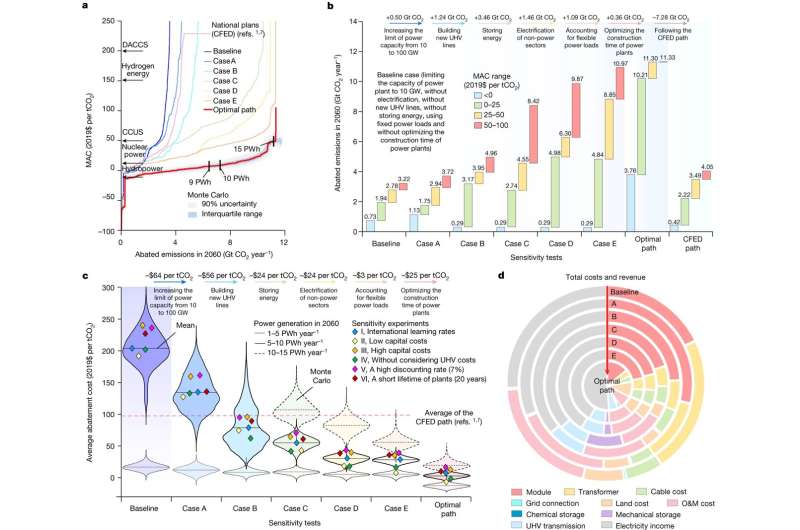This article has been reviewed according to Science X's editorial process and policies. Editors have highlighted the following attributes while ensuring the content's credibility:
fact-checked
peer-reviewed publication
trusted source
proofread
Study outlines optimal strategy for accelerating the energy transition in China

China has set itself the goal of reaching its peak of carbon dioxide emissions in 2030 and thereafter to reduce emissions to reach carbon neutrality by 2060. To achieve this, it needs to increase photovoltaic (PV) and wind power to 10–15 petawatt hours (PWh) by 2060.
However, according to historical installation rates and a recent high-resolution energy-system-model and forecasts based on China's 14th Five-Year Energy Development Programme (CFEDP), the capacity of China for producing non-fossil-fuel energy will reach a maximum of only 9.5 PWh per year by 2060.
Now, an international study with the participation of Josep Peñuelas, professor of the Spanish Council for Scientific Research (CSIC) and a CREAF researcher, and Jordi Sardans, a CREAF researcher, establishes the optimal strategy for China to achieve carbon neutrality by 2060.
The study, published this week in Nature, is led by Rong Wang, a researcher at Fudan University (China). The authors have developed a spatial method that takes into account different variables and their combination in order to reach the goal.
Variables such as the optimal location of new photovoltaic plants and wind turbines, seasonal patterns, hours of wind and available sunlight, construction time for new plants and electricity transmission lines, technology modernization, learning ratio of technical staff, energy storage, costs and necessary investment, among others.
As the authors explain, China can achieve carbon neutrality by 2060 by optimizing the deployment of 3,844 new commercial-scale photovoltaic (PV) and wind power plants, in tandem with the expansion of ultra-high-voltage transmission and energy storage systems, and considering electricity load flexibility and learning dynamics. This plan would increase its PV and wind power capacity to 15 PWh year. It would also bring the average cost of reducing a ton of carbon dioxide (tCO2) from $97 to $6.
To achieve this, the government must increase investment in clean energy, optimize energy loads and strengthen the construction of transport and storage facilities, such as long-distance ultra-high-voltage transmission lines and pumped hydroelectric power plants.
Optimizing investment
Fossil fuels still dominate energy-related investments, so the growth of renewables could slow down if subsidies to photovoltaic and wind power companies are reduced.
Deep decarbonization requires increased investment in renewables. The authors emphasize that "the importance of policy interventions to reduce the costs of renewables."
In the case of China, they estimate that annual investment in PV and wind should increase from USD 77 billion in 2020 to USD 127 billion per year in the 2020s, and to USD 426 billion per year in the 2050s.
That investment would be offset by collateral benefits such as incomes for the inhabitants of the poorest regions, regions where photovoltaics would be deployed on a large scale. Besides, if the key moments for building and outlining national clean energy development strategies are well planned, economic costs can be reduced by the middle of this century.
Professor Josep Peñuelas comments that "in this study we propose a low-cost, high-efficiency energy transition pathway, which offers the possibility of significantly reducing the costs of substituting the energy that now comes from fossil fuel-dependent, greenhouse gas-producing energy."
Implications for other countries
Jordi Sardans highlights that the deployment of photovoltaic and wind energy can provide new sources of income in less developed regions with vast desert and marginal lands. This has implications and sets an example for other global regions with similar characteristics. For instance, it could accelerate economic development by deploying renewable energies in semi-arid regions such as Africa and the Middle East.
Furthermore, points out, optimizing the energy systems of large developing countries can reduce the implementation costs of renewable energies in the coming decades, enabling more ambitious climate goals beyond carbon neutrality by 2060.
"Our research highlights the technical and physical limitations of deploying renewable energies to mitigate CO2 emissions, the importance of increasing investments to accelerate the energy transition towards photovoltaic and wind energy, and the optimal path to achieve long-term carbon neutrality," concludes Prof. Peñuelas.
More information: Rong Wang, Accelerating the energy transition towards photovoltaic and wind in China, Nature (2023). DOI: 10.1038/s41586-023-06180-8. www.nature.com/articles/s41586-023-06180-8


















